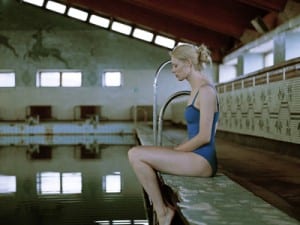Review by Emily Sack, a candidate for the MA in Art History at Richmond the American International University in London.
The tree of life, a family tree, the ‘Giving Tree’ – trees are a significant part of our everyday existence, but who really stops to look at them? Walking through any art museum, trees will be present in dozens of works, but what happens when they leave the background, no longer used as framing devices, and become the central image? Giuseppe Penone’s current exhibition at Haunch of Venison in London examines these questions by bringing focus, in a variety of media, to an overlooked aspect of our daily lives.
Working in photography, paper and pencil, wood, bronze, and graphite on canvas, Penone’s multi-media approach looks at the interaction between man and nature. In two similar works, Continuera a crescere tranne che in quel punto – radiografia (2010)(It will continue to grow except at this point – radiography) and Alpi Marittime – continuera a crescere tranne che in quell punto (1968-1978) (Maritime Alps – It will continue to grow except at this point), Penone places a steel cast of his own hand grasping the trunk of a small tree. He re-examines this same tree ten years later to find that the tree has grown around this foreign object, thereby adapting to its new situation. Trees are fascinating entities that simultaneously grow upwards, downwards and outwards, and the artist captures this in revisiting the same place over several years and examining the affect of man-made material on a natural growth process.
Through the above examples and other works, Penone demonstrates the resilience of nature despite human intervention. Though I am not sure it is meant to be an overtly environmentalist approach, the artist encourages visitors to question the relationship of humans with their surroundings in nature. In a stunning example of floor sculpture – Lo spazio della scultura – pelle di cedro (2001) (Space of sculpture – cedar skin) – Penone creates a grid of bark from a cedar tree; however, the material used is actually bronze, not real bark. The likeness is remarkable and it is difficult to believe that each element is much heavier and more rigid than it appears. In the middle of the grid of bark, one piece is elevated above the others by a contraption made of tree branches (though this too is also made of bronze). The appearance of weightlessness and malleability further compounds the paradox of materiality. Penone here calls attention to man’s ability to replicate nature; however, this skill is quite limited and complicated. The cedar skins in this piece look like bark, but it is impossible to make paper or firewood from it and it cannot produce oxygen for us to breathe.
Though the Giuseppe Penone exhibit is excellent on its own, Haunch of Venison presents his work in conjunction with an exhibition of works by Richard Long. The two exhibits work very well together because although the media utilized by each is quite different, both artists use the natural environment as their subject matter. In one of the central galleries atop a majestic staircase, Penone and Long each have a work displayed. Penone’s is entitled Spazio di Luce (2008) (Space of Light) and is composed of wood and vegetal resin. The solid monolith of wood is pierced in several locations by holes carved in the place of knots in the wood. This irregular pattern of negative space allows light to enter into the sculpture and also to compose faint spots of light in the shadow cast by the object. Here Penone is taking an element generally considered to be a flaw or blemish on the surface of the wood and makes it beautiful.
Long’s work in the same space is on a much larger scale. Stone Print Spiral of 2011 is a circular arrangment of stones that the artist extracted from a Danish River. The displacement of natural materials in both works within a gallery space allows the viewer to appreciate each for their inherent qualities instead of their place within the environment. Many of Long’s other works on display originate from the act of walking as an artwork and his methods of documenting this action. He utilizes a seemingly bizarre juxtaposition of earth art and conceptual/text based art. One of the central themes of his exhibit is that the man made is necessarily distinct from the natural, but that neither is superior or inferior.
It is rare for two artists’ exhibitions to flow together and complement each other so well, and this interaction between the Giuseppe Penone and Richard Long, especially in the shared space, provides a highly enjoyable and thought-provoking gallery experience.
Richard Long / Giuseppe Penone continues at Haunch of Venison, London until 20 Aug 2011.
haunchofvenison.com
Aesthetica Magazine
We hope you enjoying reading the Aesthetica Blog, if you want to explore more of the best in contemporary arts and culture you should read us in print too. In the spirit of celebration, Issue 41 includes a piece on Guggenheimn Bilbao where the Luminous Interval features internationally acclaimed artists such as Louise Bourgeois, Kiki Smith and Damien Hirst, ArtAngel’s new commission at MIF, Bruce Nauman’s retrospective at The Kunsthalle Mannheim and Cory Arcangel’s Pro Tools at the Whitney in NYC. You can buy it today by calling +44(0)1904 479 168. Even better, subscribe to Aesthetica and save 20%. Go on, enjoy!
Image:
Giuseppe Penone
Copyright Giuseppe Penone
Courtesy of Haunch of Venison





